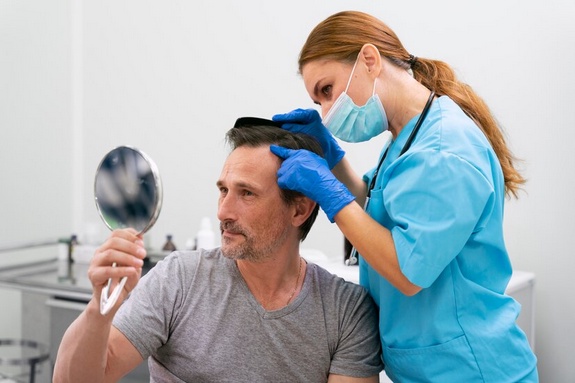Introduction
Hair, often considered a symbol of beauty and vitality, plays a significant role in shaping one's appearance and self-esteem. However, the phenomenon of hair loss is a complex and multifaceted issue that affects individuals across various age groups and genders. This comprehensive exploration seeks to unravel the intricacies of hair loss, examining its causes, types, and potential solutions.
The Anatomy of Hair and Normal Hair Growth
Before delving into the complexities of hair loss, it's essential to grasp the basics of normal hair growth. Hair grows from hair follicles embedded in the scalp. The hair growth cycle consists of three phases: the anagen phase (active growth), the catagen phase (transitional phase), and the telogen phase (resting phase). Each hair follicle operates independently, ensuring a continuous cycle of growth and shedding.
1. Causes of Hair Loss
Hair loss can result from a myriad of factors, and understanding these causes is pivotal in developing effective strategies for prevention and treatment.
a. Genetics and Hormones
Hereditary factors play a substantial role in hair loss, particularly in cases of androgenetic alopecia, commonly known as male and female pattern baldness. This genetic predisposition causes hair follicles to be sensitive to the hormone dihydrotestosterone (DHT), leading to hair thinning and eventual loss.
b. Hormonal Changes and Medical Conditions
Fluctuations in hormonal levels due to pregnancy, childbirth, menopause, and thyroid disorders can contribute to hair loss. Additionally, certain medical conditions such as alopecia areata, lupus, and diabetes may trigger hair loss as a secondary symptom.
c. Medications and Treatments
The side effects of certain medications, including chemotherapy drugs, blood thinners, and antidepressants, can lead to hair loss. Radiation therapy, used to treat cancer, also commonly causes hair loss in the treated area.
d. Poor Nutrition and Diet
A diet lacking essential nutrients, particularly iron, zinc, vitamins A and D, and protein, can impact hair health. Inadequate nutrition weakens hair strands and may lead to increased shedding.
2. Types of Hair Loss
Hair loss manifests in various forms, each with its unique characteristics and causes.
a. Androgenetic Alopecia
This hereditary condition is the most common cause of hair loss, affecting both men and women. It typically follows a pattern of receding hairline and thinning at the crown for men, while women may experience overall thinning.
b. Telogen Effluvium
Telogen effluvium is characterized by a widespread shedding of hair. It often occurs in response to significant stressors, such as childbirth, surgery, or extreme weight loss, disrupting the normal hair growth cycle.
c. Alopecia Areata
Alopecia areata is an autoimmune disorder that causes hair loss in patches. The immune system mistakenly attacks hair follicles, leading to sudden and unpredictable hair loss.
d. Traction Alopecia
Excessive pulling or tension on the hair, often due to tight hairstyles or the use of hair extensions, can result in traction alopecia. This type of hair loss is preventable by avoiding hairstyles that put undue stress on the hair.
3. Treatment Options for Hair Loss
Several approaches can be taken to address and manage hair loss, depending on its cause and severity.
a. Topical Treatments
Minoxidil, a topical solution, is an FDA-approved treatment for androgenetic alopecia. It stimulates blood flow to the hair follicles, promoting hair growth. Similarly, certain shampoos and foams may contain active ingredients that support hair health.
b. Oral Medications
Finasteride, an oral medication, is effective in treating androgenetic alopecia in men by inhibiting the production of DHT. However, it's important to note that this medication may have side effects and is not suitable for women.
c. Platelet-Rich Plasma (PRP) Therapy
PRP therapy involves injecting concentrated platelets from the patient's blood into the scalp, stimulating hair follicles and promoting hair growth. While research is ongoing, some individuals have experienced positive results with this minimally invasive procedure.
d. Hair Transplantation
For individuals seeking a more permanent solution, hair transplantation involves moving hair follicles from donor areas to areas with thinning or no hair. Advanced techniques, such as Follicular Unit Extraction (FUE), have made this surgical option more precise and less invasive.
Conclusion
Hair loss is a complex and nuanced phenomenon influenced by a combination of genetic, hormonal, environmental, and lifestyle factors. Understanding the intricacies of hair loss is crucial for individuals seeking to address and manage this common concern effectively. Whether opting for topical treatments, oral medications, innovative therapies like PRP, or more permanent solutions like hair transplantation, individuals can find approaches that align with their preferences and needs. By recognizing the root causes and exploring appropriate treatment options, individuals can embark on a journey toward healthier, more resilient hair, reclaiming their confidence and embracing their natural beauty.


No comments yet